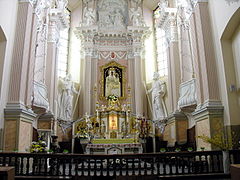- Our Lady of Šiluva
-
Our Lady of Šiluva is Roman Catholic icon of the Virgin Mary in Šiluva, Lithuania. A Cathedral of the same name has been built and is dedicated to it. The icon is highly venerated in Lithuania and is often called "Lithuania's greatest treasure".[1]
The icon is painted in the Our Lady of the Way style, and is similar to the famous Madonna Salus Populi Romani.[1] According to legend, the miraculous icon was brought to Siluva from Rome in 1457 as a gift to Lithuanian nobleman Petras Gedgaudas.[2]
A reported 17th century Marian apparition associated with the icon resulted in the discovery of the deed to a church that had been left for safekeeping, and resulted in increased pilgrimages to the site.[3] Pope Pius VI approved devotions to Our Lady of Šiluva and granted indulgences for them.[2]
See also
- Marian devotions
- Marian apparitions
- Our Lady of the Gate of Dawn
Sources
- ^ a b University of Dayton
- ^ a b The other faces of Mary: stories, devotions, and pictures of the Holy Virgin around the world by Ann Ball 2004 ISBN 0824522559 page 153
- ^ Ann Ball, 2003 Encyclopedia of Catholic Devotions and Practices ISBN 0-87973-910-X page 536
Categories:- Roman Catholic Church stubs
- Marian shrines
- Marian apparitions
- Paintings of the Virgin Mary
Wikimedia Foundation. 2010.

